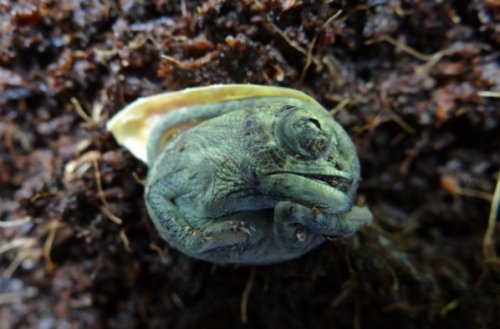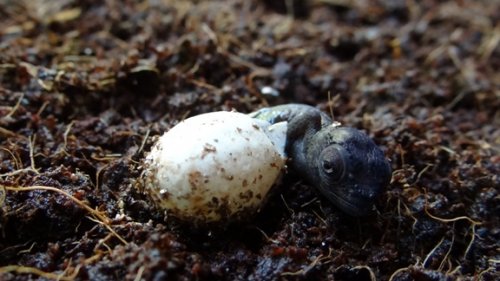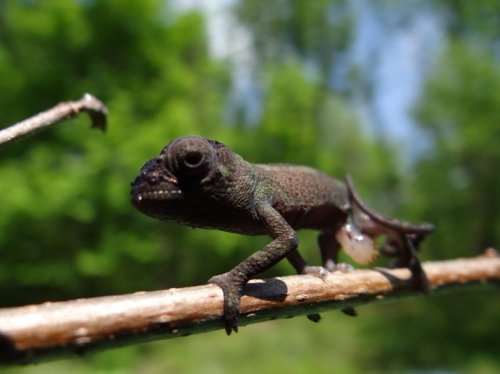pamnsam94
Established Member
Just thought I would share my last two experiences with T. q. quadricornis eggs.
16 eggs laid on 11/28/11;
10 eggs hatched on 4/30/12 (two other eggs deflated that day but failed to hatch; one of them had a very small slit but apparently both the neonates in those two eggs were simply too weak to cut their way out and died);
2 eggs hatched on 5/1/11;
1 egg hatched today (5/2/12) but the neonate has a severely kinked tail;
the last egg is in the process of hatching now (I've never seen this before but the egg has slits at both ends);
the incubation medium was 100% vermiculite (an equal amount (by weight) of RO water was mixed with the vermiculite; the container was about 1/4 full with the mixture;
the incubation container was a Glad food container (approximately 9" x 9"); no holes were put in the container; it was simply put in a room that stays around 70F year round and covered with a black cloth; very infrequently (about once a month) the eggs were checked on an the lid was opened; however around 4 1/2 months, they were checked more frequently (a few times a week); all 16 eggs laid went full term; the eggs had light brown spots which differed from other clutches I've had where the eggs were totally white; also kind of interesting is that when these eggs sweated, they did not have very visible beads/droplets of water on them
On another note, the mother was given a drop of pre-formed vitamin A once a month. With the last clutch of quad eggs I had (different female) the mother did not get preformed vitamin A; all of her eggs were dropped over a 5 day time period from where she was perched despite having suitable egg deposition sites. The eggs were fully calcified and all white (they actually looked better than this most recent clutch). I incubated them the same as this clutch. Most of them went bad from 3 to 4 1/2 months. Surprisingly though, when I cut the eggs open, there was no embryo and no sign of vascularization at all. The one remaining egg (out of 10 total) made it to just under 5 months then went bad. I opened it up expecting nothing but that egg had a fully formed baby. Apparently, it was just too weak to emerge. That experience plus some info I read on panther chameleon egg viability is what made me decide to try preformed vitamin A on the mother of this most recent clutch.
Perry
16 eggs laid on 11/28/11;
10 eggs hatched on 4/30/12 (two other eggs deflated that day but failed to hatch; one of them had a very small slit but apparently both the neonates in those two eggs were simply too weak to cut their way out and died);
2 eggs hatched on 5/1/11;
1 egg hatched today (5/2/12) but the neonate has a severely kinked tail;
the last egg is in the process of hatching now (I've never seen this before but the egg has slits at both ends);
the incubation medium was 100% vermiculite (an equal amount (by weight) of RO water was mixed with the vermiculite; the container was about 1/4 full with the mixture;
the incubation container was a Glad food container (approximately 9" x 9"); no holes were put in the container; it was simply put in a room that stays around 70F year round and covered with a black cloth; very infrequently (about once a month) the eggs were checked on an the lid was opened; however around 4 1/2 months, they were checked more frequently (a few times a week); all 16 eggs laid went full term; the eggs had light brown spots which differed from other clutches I've had where the eggs were totally white; also kind of interesting is that when these eggs sweated, they did not have very visible beads/droplets of water on them
On another note, the mother was given a drop of pre-formed vitamin A once a month. With the last clutch of quad eggs I had (different female) the mother did not get preformed vitamin A; all of her eggs were dropped over a 5 day time period from where she was perched despite having suitable egg deposition sites. The eggs were fully calcified and all white (they actually looked better than this most recent clutch). I incubated them the same as this clutch. Most of them went bad from 3 to 4 1/2 months. Surprisingly though, when I cut the eggs open, there was no embryo and no sign of vascularization at all. The one remaining egg (out of 10 total) made it to just under 5 months then went bad. I opened it up expecting nothing but that egg had a fully formed baby. Apparently, it was just too weak to emerge. That experience plus some info I read on panther chameleon egg viability is what made me decide to try preformed vitamin A on the mother of this most recent clutch.
Perry







